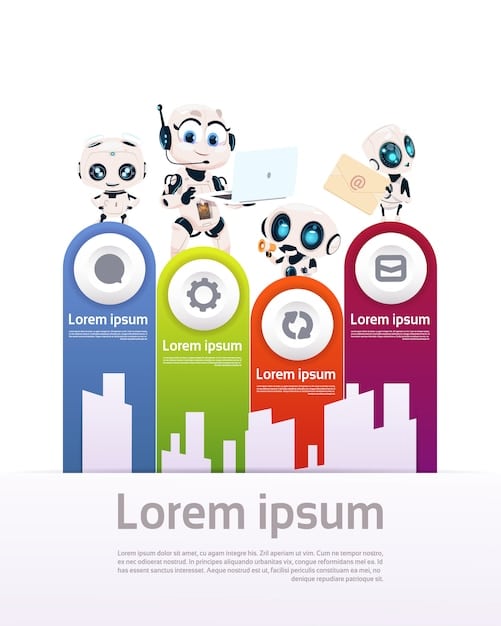AI’s Role in Business: Applications & Implementation

Advertisements
The role of artificial intelligence in business is rapidly expanding, with applications spanning from data analysis and automation to customer service and strategic decision-making, necessitating robust implementation strategies for competitive advantage and sustainable growth.
Advertisements
The profound impact of artificial intelligence (AI) has transcended theoretical discussions, becoming a tangible force reshaping commerce, industry, and daily operations. Understanding the role of artificial intelligence in business: applications and implementation strategies is no longer an option but a strategic imperative for organizations aiming to thrive in an increasingly data-driven world.
understanding artificial intelligence in the modern enterprise
Artificial Intelligence (AI) refers to the simulation of human intelligence processes by machines, especially computer systems. These processes include learning (the acquisition of information and rules for using the information), reasoning (using rules to reach approximate or definite conclusions), and self-correction. In the realm of business, AI is not merely a tool for automation but a transformative technology capable of driving unprecedented efficiencies, fostering innovation, and unveiling new revenue streams.
Advertisements
The proliferation of big data, coupled with advances in computational power and sophisticated algorithms, has propelled AI from a niche academic pursuit to a mainstream business differentiator. Companies worldwide are recognizing that leveraging AI is crucial for maintaining a competitive edge, improving operational effectiveness, and delivering superior customer experiences. This paradigm shift requires a foundational understanding of AI’s capabilities and its strategic integration into existing business models.
the core pillars of ai in business
AI in business is underpinned by several key technologies, each contributing distinct capabilities to the enterprise ecosystem. Understanding these components is essential for effective deployment and maximizing their impact.
- Machine Learning (ML): At its heart, ML enables systems to learn from data without explicit programming. This capability is vital for predictive analytics, personalized recommendations, and anomaly detection, transforming raw data into actionable insights for business decisions.
- Natural Language Processing (NLP): NLP allows computers to understand, interpret, and generate human language. Its applications range from enhancing customer service through chatbots and virtual assistants to performing sentiment analysis on customer feedback and automating document processing.
- Computer Vision: This field enables computers to “see” and interpret visual information from the world, much like human vision. In business, computer vision is used for quality control in manufacturing, facial recognition for security, and analyzing visual data for retail insights.
- Robotics Process Automation (RPA): While not AI in itself, RPA often works in conjunction with AI to automate repetitive, rule-based tasks traditionally performed by humans. When combined with AI, RPA can handle more complex, cognitive processes, freeing up human employees for higher-value activities.
Beyond these foundational elements, AI applications are continually evolving, encompassing areas like expert systems, speech recognition, and planning. The strategic implementation of these technologies requires a clear vision, a phased approach, and a commitment to continuous learning and adaptation within the organization.
Embracing AI signifies more than just adopting new technology; it represents a fundamental shift in how businesses operate, innovate, and compete. It demands a culture that values data, experimentation, and cross-functional collaboration, ensuring that AI initiatives are aligned with overarching business objectives and deliver tangible value.

key applications of ai across business functions
The transformative power of AI extends across virtually every business function, offering innovative solutions to long-standing challenges and unlocking new opportunities for growth and efficiency. From streamlining operations to revolutionizing customer engagement, AI is proving to be an indispensable asset.
enhancing customer experience
Customer experience (CX) is a critical battleground for businesses, and AI plays a pivotal role in delivering personalized, efficient, and proactive interactions. AI-powered tools are reshaping how companies understand and serve their customers.
- Chatbots and Virtual Assistants: These AI applications provide instant, 24/7 support, answering common queries, guiding customers through processes, and resolving issues without human intervention. This improves response times and frees up human agents for more complex interactions.
- Personalized Marketing and Recommendations: AI algorithms analyze vast amounts of customer data, including browsing history, purchase patterns, and demographics, to deliver highly personalized product recommendations and marketing messages, significantly boosting engagement and sales.
- Sentiment Analysis: By processing customer feedback from various channels (social media, reviews, support calls), AI can gauge sentiment, identify pain points, and enable businesses to address customer dissatisfaction proactively, leading to improved loyalty.
optimizing operations and efficiency
Operational efficiency is a cornerstone of profitability, and AI offers unparalleled capabilities for streamlining processes, reducing waste, and improving decision-making across the enterprise.
In manufacturing, AI-driven predictive maintenance systems analyze sensor data from machinery to anticipate failures before they occur, minimizing downtime and maintenance costs. This proactive approach ensures continuous production and extends the lifespan of critical assets. Supply chain management also benefits significantly from AI, which can optimize routing, forecast demand with greater accuracy, and manage inventory levels to prevent overstocking or shortages. This leads to substantial cost savings and improved delivery times.
Furthermore, AI-powered automation extends beyond physical processes to administrative tasks. Automated invoicing, data entry, and report generation reduce manual errors and free human staff to focus on strategic initiatives that require critical thinking and creativity. Fraud detection systems, leveraging AI’s ability to identify anomalies in vast datasets, protect businesses from financial losses and enhance security across various transactions.
streamlining financial processes
The financial sector is a significant beneficiary of AI, which is being deployed to improve everything from risk assessment to fraud detection.
- Fraud Detection: AI algorithms can analyze billions of transactions in real-time, identifying suspicious patterns indicative of fraudulent activity far more effectively and rapidly than human analysts, significantly reducing financial losses.
- Algorithmic Trading: In financial markets, AI-powered algorithms execute trades at high speeds, based on complex models that consider market trends, news, and other data points, often outperforming human traders.
- Credit Scoring and Risk Assessment: AI can process a broader range of data points than traditional models to assess creditworthiness and predict loan defaults more accurately, leading to more informed lending decisions and reduced risk for financial institutions.
The integration of AI into financial operations not only enhances security and efficiency but also enables financial institutions to offer more personalized and competitive services to their clients. This multifaceted application of AI underscores its versatility and strategic value across diverse business functions, driving innovation and competitive advantage.
data strategy and infrastructure for ai implementation
The successful implementation of AI in business hinges fundamentally on a robust data strategy and a well-designed infrastructure. AI models are only as good as the data they are trained on, making data quality, accessibility, and governance paramount for any AI initiative.
the centrality of data quality
High-quality data is the lifeblood of effective AI. Dirty, inconsistent, or biased data can lead to skewed insights, flawed predictions, and ultimately, poor business decisions. Therefore, organizations must invest in processes and technologies that ensure data cleanliness, accuracy, and completeness.
- Data Cleansing and Pre-processing: Before data can be fed into AI models, it typically requires significant cleansing to remove errors, duplicates, and inconsistencies. Pre-processing involves transforming raw data into a format suitable for analysis, including normalization and feature engineering.
- Data Governance Frameworks: Establishing clear data governance policies is crucial. This includes defining data ownership, establishing standards for data collection and storage, and implementing measures for data security and privacy compliance (e.g., GDPR, CCPA).
- Addressing Data Bias: AI models can perpetuate and amplify existing biases present in the training data. Proactive measures must be taken to identify and mitigate biases, ensuring fairness and ethical outcomes, especially in sensitive applications like hiring or lending.
A comprehensive data quality strategy involves cross-functional collaboration, with IT, data scientists, and business units working together to define data requirements, ensure data integrity, and address any potential biases. Without clean, relevant, and unbiased data, even the most sophisticated AI algorithms will fail to deliver meaningful value.
building scalable ai infrastructure
Beyond data quality, the underlying technical infrastructure must be capable of supporting the computational demands of AI models and ensuring their seamless integration into business workflows. This often involves a blend of cloud and on-premise solutions.
Cloud computing platforms (e.g., AWS, Azure, Google Cloud) offer scalable and flexible resources, allowing businesses to access high-performance computing power, specialized AI services, and vast storage capabilities on demand. This eliminates the need for significant upfront hardware investments and provides the agility required for rapid AI development and deployment. Edge computing, which processes data closer to its source, is also gaining traction for AI applications requiring real-time insights or operating in environments with limited connectivity.
Furthermore, the infrastructure must support the entire AI lifecycle, from data ingestion and model training to deployment and continuous monitoring. This necessitates robust data pipelines, machine learning operations (MLOps) platforms for managing model lifecycle, and integration layers that allow AI outputs to be consumed by business applications. Investing in the right infrastructure ensures that AI initiatives are not only technically feasible but also scalable, reliable, and able to deliver sustained business value.
Ultimately, a successful AI implementation journey begins with a strategic appreciation for data: its quality, its governance, and the infrastructure required to harness its full potential. Businesses that prioritize these foundational elements are better positioned to unlock AI’s transformative capabilities and realize a tangible return on their AI investments.
implementation strategies: from pilot to enterprise-wide adoption
Implementing AI within an organization is a complex journey that extends far beyond merely acquiring technology. It requires a strategic, phased approach, starting with pilot projects and gradually scaling to enterprise-wide adoption, while addressing cultural, ethical, and operational challenges.
the pilot project approach
Starting with small, manageable pilot projects is a prudent strategy for AI implementation. This approach allows organizations to test AI concepts, validate their value proposition, and gain critical insights and experience without committing significant resources upfront. Pilot projects should focus on well-defined problems with measurable outcomes.
- Identify High-Impact, Low-Risk Areas: Choose areas where AI can deliver clear, quantifiable benefits, such as automating a repetitive task or improving a specific customer service interaction. These projects should have accessible data and enthusiastic stakeholders.
- Define Success Metrics Clearly: Before starting, establish specific, measurable, achievable, relevant, and time-bound (SMART) goals for the pilot. How will success be measured? (e.g., “reduce processing time by 20%,” “improve customer satisfaction scores by 10%”).
- Iterate and Learn: Treat the pilot as a learning opportunity. Collect feedback, analyze results, and be prepared to iterate on the model or the implementation process. Lessons learned from pilots are invaluable for future, larger-scale deployments.
Successful pilots build internal confidence, demonstrate tangible ROI, and generate momentum for broader AI initiatives. They also help in identifying potential challenges in data availability, integration, or user adoption early on.
scaling ai across the enterprise
Once initial pilots prove successful, the challenge shifts to scaling AI solutions across various departments and business units. This requires a more comprehensive strategy encompassing technology, people, and processes.
Establishing a dedicated AI center of excellence (CoE) or a cross-functional AI task force can facilitate knowledge sharing, promote best practices, and centralize governance of AI initiatives. This team can serve as a hub for AI expertise, fostering a culture of innovation and ensuring consistency in AI development and deployment. Furthermore, investing in internal talent development—upskilling existing employees and hiring new AI specialists—is critical for building sustainable AI capabilities within the organization.
Integration with existing systems is another key consideration. AI solutions must seamlessly plug into current IT infrastructure and business workflows to maximize their impact and minimize disruption. This often involves developing APIs and robust data integration layers. Additionally, a strong change management strategy is essential to prepare employees for the introduction of AI, address concerns about job displacement, and emphasize how AI can augment human capabilities, not replace them entirely.
From initial experimentation to widespread adoption, a successful AI implementation strategy prioritizes measurable impact, continuous learning, and effective change management, ensuring that AI becomes an embedded, value-generating component of the business ecosystem.
ethical considerations and responsible ai deployment
As artificial intelligence becomes increasingly integrated into business operations, the ethical implications of its deployment come into sharp focus. Responsible AI development and deployment are not just matters of compliance but fundamental pillars for building trust, ensuring fairness, and fostering long-term sustainability for businesses and society.
addressing bias and fairness
One of the most pressing ethical concerns in AI is the potential for bias. AI models learn from the data they are trained on, and if this data reflects existing societal biases, the AI can perpetuate or even amplify these biases in its decisions. This can lead to discriminatory outcomes in sensitive areas like hiring, loan approvals, or criminal justice.
To mitigate bias, businesses must: (1) Scrupulously examine training data for inherent biases and work to diversify and clean datasets. (2) Implement fairness metrics and tools to detect and measure bias during model development and deployment. (3) Prioritize transparency, explaining how AI decisions are made (explainable AI or XAI) to allow for scrutiny and accountability. (4) Establish human oversight mechanisms to review and override AI decisions when necessary, particularly in high-stakes contexts.
Ensuring fairness in AI ensures compliance with regulations and builds public trust, crucial for the widespread acceptance and positive impact of AI technologies.
privacy and data security
AI systems often rely on vast amounts of data, much of which can be personal or sensitive. Protecting this data from misuse, breaches, and unauthorized access is an paramount ethical and legal responsibility for businesses deploying AI.
- Anonymization and Pseudonymization: Implementing techniques to anonymize or pseudonymize data wherever possible reduces the risk of identifying individuals while still allowing AI models to leverage the data for insights.
- Robust Security Measures: Employing state-of-the-art cybersecurity protocols, including encryption, access controls, and regular security audits, is essential to protect AI systems and their underlying data from cyber threats.
- Compliance with Regulations: Adhering to data protection regulations such as GDPR, CCPA, and industry-specific mandates is non-negotiable. Businesses must ensure their AI practices are fully compliant with these frameworks.
Beyond technical measures, businesses should cultivate a culture of privacy awareness among employees and transparently communicate their data privacy practices to customers. Responsible data stewardship strengthens customer trust and reduces the risk of reputational damage or legal repercussions.
transparency and accountability
The “black box” nature of some advanced AI models, where it is difficult to understand how a decision was reached, poses significant ethical challenges. Businesses need to strive for greater transparency and accountability in their AI deployments.
Implementing explainable AI (XAI) techniques helps demystify AI decision-making processes, making them more understandable to both technical experts and laypersons. This is particularly important in regulated industries where justification for decisions may be required. Establishing clear lines of accountability for AI outcomes, including who is responsible for AI errors or biases, is also critical. An ethical AI framework within an organization should include a review board or committee responsible for overseeing AI governance, ethics, and compliance, ensuring that AI is used in a manner that aligns with organizational values and societal expectations.
By proactively addressing these ethical considerations, businesses can harness the immense power of AI while safeguarding individual rights, building societal trust, and ensuring that AI serves as a force for good.
emerging trends and the future of ai in business
The landscape of AI in business is dynamic, with continuous innovation driving new trends and shaping the future of enterprise operations. Staying abreast of these emerging developments is crucial for businesses aiming to capitalize on AI’s full potential.
hyper-personalization and adaptive ai
Beyond current personalization efforts, the future of AI promises hyper-personalization, where AI systems can adapt to individual user preferences and behaviors in real-time, delivering truly unique experiences. This involves more sophisticated AI models that can understand context, predict needs, and even anticipate emotions.
Applications will extend from highly tailored product recommendations to dynamic content generation, adaptive learning platforms, and even personalized healthcare. This trend, driven by advancements in reinforcement learning and contextual AI, will enable businesses to forge deeper, more meaningful connections with their customers, fostering unparalleled brand loyalty.
ai-powered decision-making augmentation
While AI can automate decisions, its future role increasingly involves augmenting human decision-making, providing insights and recommendations that enable better, faster, and more informed choices. This includes leveraging AI for complex strategic planning, risk management, and even creative problem-solving.
- Prescriptive Analytics: AI will move beyond just predicting what will happen to recommending specific actions to take for optimal outcomes, offering detailed guidance on next steps.
- Simulations and Digital Twins: AI-powered simulations and digital twins will allow businesses to model complex scenarios, test hypotheses, and evaluate the impact of decisions in a virtual environment before real-world implementation.
- Enhanced Collaboration: AI tools will facilitate collaboration by summarizing discussions, identifying action items, and providing relevant data points, making team interactions more productive.
This shift from automation to augmentation underscores AI’s role as a strategic partner, enhancing human capabilities and enabling organizations to navigate complex environments with greater confidence and agility.
the rise of explainable and responsible ai
As AI becomes more pervasive, the demand for transparency and ethical deployment will intensify. Future AI systems will increasingly incorporate explainability into their core design, allowing users to understand why decisions are made, not just what decisions are made. This “glass box” approach enhances trust and facilitates regulatory compliance.
Moreover, the focus on responsible AI will broaden to include robust frameworks for fairness, accountability, and safety at every stage of the AI lifecycle. Businesses will increasingly adopt comprehensive ethical guidelines, implement AI audit mechanisms, and invest in diverse AI teams to ensure the development and deployment of AI that is beneficial and equitable for all stakeholders. This commitment to responsible AI will be a distinguishing factor for leading organizations.
The future of AI in business is characterized by increasingly sophisticated, adaptive, and ethically conscious applications. Businesses that embrace these emerging trends, invest in continuous learning, and prioritize responsible innovation will be well-positioned to unlock unprecedented value and redefine their competitive advantage in the years to come.
overcoming challenges in ai adoption
Despite the immense promise of AI, its successful adoption within businesses is often hampered by a range of challenges. Recognizing and proactively addressing these hurdles is critical for organizations to fully realize the benefits of their AI investments.
talent gap and skill development
One of the most significant challenges in AI adoption is the shortage of skilled professionals. The demand for data scientists, machine learning engineers, AI ethicists, and prompt engineers far outstrips the current supply. This talent gap can slow down implementation, increase costs, and limit the scope of AI initiatives.
- Upskilling and Reskilling Existing Employees: Investing in training programs to equip current staff with AI-related skills can mitigate the talent crunch. This includes data literacy, AI fundamentals for business leaders, and specialized technical training for IT and data teams.
- Strategic Hiring: Actively recruiting AI specialists with diverse backgrounds and expertise is essential. Businesses should offer competitive packages and foster an environment conducive to innovation and continuous learning.
- Partnerships with Academia and Startups: Collaborating with universities and AI startups can provide access to cutting-edge research, talent pipelines, and specialized solutions, accelerating AI adoption.
Addressing the talent gap requires a multi-faceted approach that combines internal development with external recruitment and strategic partnerships, building a sustainable AI ecosystem within the organization.
integration complexities and legacy systems
Integrating new AI solutions with existing legacy IT systems poses another considerable challenge. Many older systems were not designed to handle the volume and velocity of data required for AI, nor do they support seamless integration with modern AI platforms.
Moreover, disparate data silos across different departments can hinder efforts to create a unified data source necessary for effective AI training and deployment. Overcoming this requires robust data integration strategies, potentially involving data lakes or data warehouses, and the use of APIs and middleware to connect disparate systems. A phased integration approach, focusing on modular implementation, can also help manage complexity and minimize disruption to ongoing operations. This often means modernizing parts of the IT infrastructure or investing in advanced integration platforms that can bridge the gap between old and new technologies.
cultural resistance and change management
Technology adoption is as much about people as it is about machines. Cultural resistance to AI, often stemming from fear of job displacement or a lack of understanding, can significantly impede successful implementation. Employees may be hesitant to embrace new workflows or feel threatened by AI-powered automation.
Effective change management is paramount. This involves transparent communication about the goals and benefits of AI, emphasizing how AI will augment human capabilities rather than replace them. Providing adequate training, involving employees in the design and implementation process, and demonstrating early successes can help alleviate fears and build enthusiasm. Fostering a culture of learning, experimentation, and adaptability is crucial to ensure that the workforce is ready and willing to embrace AI as a tool for innovation and growth. Leading by example, where senior management actively advocates for and uses AI, can also significantly influence cultural acceptance.
By proactively addressing these challenges—from investing in talent and modernizing infrastructure to fostering a resilient and adaptable culture—businesses can clear the path for successful AI adoption and unlock its full transformative potential.

measuring roi and ensuring sustained value from ai initiatives
Demonstrating a clear return on investment (ROI) and ensuring sustained value are crucial for the long-term success and continued funding of AI initiatives. Businesses must move beyond mere pilot projects and integrate AI into their core strategy with clear metrics for success.
defining and tracking roi for ai
Measuring ROI for AI can be complex due to its often intangible benefits and long-term impact. However, it is essential to define clear metrics and track them rigorously. ROI for AI isn’t always about immediate financial gains; it can also encompass improvements in efficiency, customer satisfaction, and risk reduction.
- Direct Cost Savings: Quantify savings from automation (e.g., reduced labor costs, lower operational expenses due to predictive maintenance).
- Revenue Growth: Measure increased sales driven by AI-powered personalization, improved lead generation, or new product development.
- Efficiency Gains: Track improvements in processing times, reduction in errors, or faster decision-making cycles.
- Customer Satisfaction and Retention: Monitor metrics like Net Promoter Score (NPS), customer lifetime value (CLTV), and churn rates to assess the impact of AI on CX.
- Risk Reduction: Evaluate the decrease in fraud losses, compliance breaches, or operational downtime attributable to AI.
Establishing baseline metrics before AI implementation and regularly comparing them against post-implementation data allows for a clear assessment of AI’s impact. A balanced scorecard approach, combining financial and non-financial metrics, often provides a more holistic view of AI’s value.
continuous improvement and maintenance of ai models
AI models are not a “set it and forget it” solution. Their effectiveness diminishes over time due to concept drift (changes in data patterns or relationships) and data drift (changes in the characteristics of input data). Ensuring sustained value requires continuous monitoring, retraining, and optimization.
Implementing a robust MLOps (Machine Learning Operations) framework is critical for managing the AI lifecycle, from deployment to ongoing maintenance. MLOps ensures that models are monitored for performance degradation, automatically retrained with new data when necessary, and seamlessly redeployed without disrupting operations. Regular audits of AI systems are also important to ensure they remain fair, compliant, and perform as expected.
Beyond technical maintenance, businesses should foster a culture of continuous learning and adaptation. This involves regularly reviewing AI applications, identifying new opportunities for enhancement, and exploring emerging AI technologies that can further optimize existing solutions. Feedback loops from business users and customers are invaluable for identifying areas for improvement and ensuring that AI continues to meet evolving business needs.
By thoughtfully defining ROI metrics, diligently tracking performance, and committing to ongoing maintenance and improvement, businesses can ensure that their AI investments deliver not just initial gains but sustained, long-term strategic value across the enterprise.
| Key Aspect | Brief Description |
|---|---|
| 🚀 Strategic Applications | AI optimizes customer experience, streamlines operations, and enhances financial processes across diverse business functions. |
| 📊 Data Foundation | High-quality data and robust infrastructure are crucial for effective AI and reliable insights. |
| ⚙️ Implementation Approach | Start with pilot projects, then scale gradually, integrating AI into existing systems with effective change management. |
| ⚖️ Ethical Deployment | Address bias, ensure data privacy, and maintain transparency for responsible and trustworthy AI use. |
frequently asked questions about ai in business
▼
The primary role of AI in business today is to enhance efficiency, drive innovation, and improve decision-making across various functions. AI automates repetitive tasks, provides predictive insights from vast datasets, and optimizes complex processes, allowing businesses to operate more strategically and competitively in dynamic markets.
▼
AI significantly improves customer experience through personalized interactions, 24/7 support via chatbots, and proactive issue resolution. It analyzes customer data to tailor product recommendations, detects sentiment from feedback, and automates responses, leading to faster service, higher satisfaction, and stronger customer loyalty for businesses.
▼
Key challenges in AI implementation include a significant talent gap, complexities in integrating AI with legacy systems, and cultural resistance within organizations. Overcoming these requires investing in skill development, modernizing IT infrastructure, and implementing effective change management strategies to foster employee acceptance and collaboration with AI tools.
▼
Data quality is crucial for AI success because AI models learn directly from the data they are trained on. Inaccurate, incomplete, or biased data will lead to flawed predictions and unreliable insights, undermining the effectiveness of any AI solution. High-quality data ensures accurate, fair, and actionable AI-driven business decisions.
▼
Businesses can measure AI ROI by tracking direct cost savings from automation, revenue growth from personalized sales, efficiency gains in operations, improvements in customer satisfaction, and reductions in business risk. A holistic approach combining financial and operational metrics provides a comprehensive view of AI’s value proposition.
conclusion
The pervasive influence of artificial intelligence in business is undeniable, fundamentally reshaping operations, customer engagement, and strategic planning. Successful integration of AI transcends mere technological adoption; it demands a comprehensive understanding of its broad applications, meticulous data strategies, and carefully considered implementation approaches. Businesses that navigate the complexities of AI—from fostering internal expertise and modernizing infrastructure to prioritizing ethical considerations and effectively managing change—are poised to unlock unprecedented efficiencies, drive innovation, and secure a significant competitive advantage in the evolving global economy. The journey towards an AI-powered future is continuous, marked by ongoing learning, adaptation, and a strategic commitment to harnessing AI’s transformative capacity for sustained growth and value creation.





